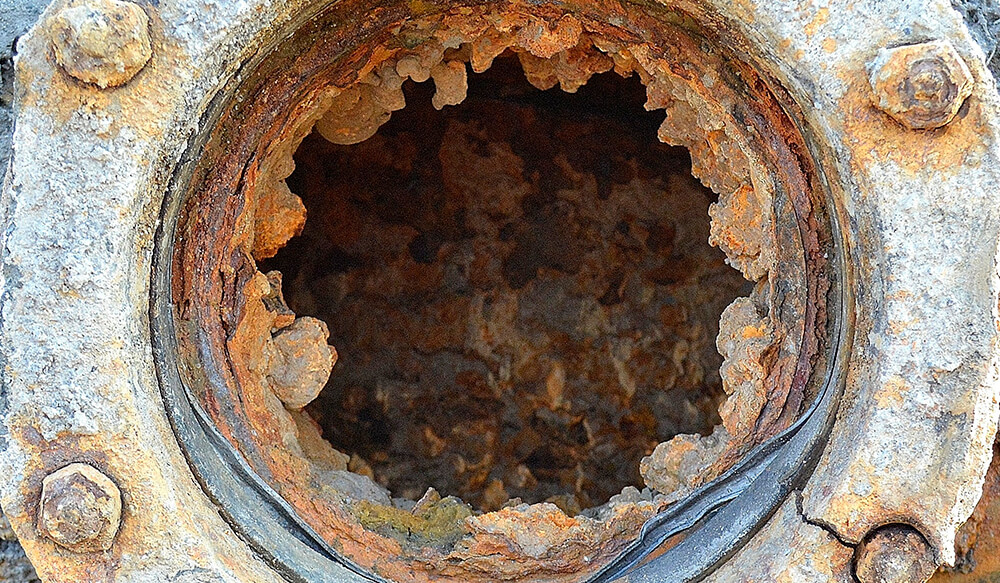
If you need your piping system to perform, corroded pipes are the enemy. Once corrosion sets in, it can spread, weaken your whole system, and cost millions of dollars in damage.
But you can fight back. It’s time to put an end to corroded pipes once and for all. Here’s how piping companies are stopping corrosion and how you can too.
What Causes Corroded Pipes?
Before you can defeat any enemy, you need to know what you’re up against. Here’s a list of the common types of corrosion:
- Galvanic corrosion
- Crevice corrosion
- Erosion corrosion
- Stress-corrosion cracking
- Saltwater corrosion
Each of these types of corrosion has a unique way of attacking piping systems. And some industries are more vulnerable to certain types than others. Here’s how each form of corrosion looks in action, where we’ve seen corrosion hit industries hardest, and how to stop it once and for all.
Galvanic Corrosion
It goes by many names: galvanic corrosion, dissimilar metal corrosion, two-metal corrosion. But its dangers are all the same. This is where two dissimilar metals are paired up and cause an electrochemical reaction. The result is rust and destroyed metal.
The solution?
If you want to stop metal-on-metal corrosion, you’ll want to use pipe supports that isolate or elevate metal pipes. For instance, you can use composite pipe shoes to lift pipes off surrounding metals. Wear pads, slide plates, and other isolators provide a similar barrier between metals that otherwise would cause damage.
APP’s Solution in Action
Galvanic corrosion affects piping systems in all industries, but it can be especially brutal in facilities that plan big expansion projects. In one recent case, a prominent refinery in Colombia tried to fight off corrosion by redirecting runoff. Unfortunately, its solution paired round bars with tapered concrete bases, which was leading to point loading and metal-on-metal damage. We stepped in and supplied 45,000 wear pads to keep the metal surfaces from direct contact.
Crevice Corrosion
Crevice corrosion sets in when corrosive materials slide into small surface holes or gaps in joints. Pipes that are exposed to corrosive elements such as chemicals and high levels of friction are especially vulnerable to crevice corrosion. In industries such as the petrochemical industry, grimy substances can slip into worn surface spots and destroy full sections of pipes or pipe supports.
APP’s Solution in Action
In one recent case, we helped Exxon Mobil prevent this type of corrosion by delivering more than 5,000 ProTek Composite Wear Pads in the span of three weeks. These wear pads reduced the metal-on-metal friction that can lead to holes in surface metal.
Erosion Corrosion
Erosion corrosion occurs when elements wear down metallic surfaces. As metals grind down, they become even more susceptible to corrosion. This type of corrosion is especially prominent in midstream projects that use pumps or compressors. That’s because these energy producers cause vibrating metals to rub against one another, which damages their outer metallic surfaces.
APP’s Solution in Action
You can stop erosion corrosion by dampening vibrations with pipe restraints or minimizing wear with supports such as wear pads or pipe shoes. We helped Kinder Morgan protect its system from erosion corrosion by delivering composite wear pads and pipe shoes that stopped metal from rubbing on harsh, abrasive surfaces.
Stress-Corrosion Cracking
Stress-corrosion cracking usually occurs when metal faces a combination of stress and abrupt temperature changes. In many cases, manufacturing processes such as welding can leave little cracks in metallic surfaces. These cracks can spread and break. And the effect can be amplified when these vulnerable areas are exposed to temperature changes.
One way to prevent stress-corrosion cracking is to minimize welding. You can cut down on excessive welding by using tools such as adjustable pipe supports, pipe clamps, or pipe shoes. These supports can be removed and installed without the need to weld or alter pipe surfaces.
APP’s Solution in Action
We knew the difficulties welding and temperature changes can cause. So when the Gulf Pascagoula LNG project called, we supplied 2,000 easy-to-install supports, including CryoTek Pipe Shoes, ranging in size from 4 inches to 36 inches long. These shoes ultimately saved the team $1 million during the installation process. At the same time, these nonmetallic shoes reduced the need to weld on the cold system and the risks of stress-corrosion cracking.
Saltwater Corrosion
You probably guessed it: Saltwater corrosion is caused by heavy exposure to salt. It’s a common concern for industries dealing with salt-heavy air, including the marine industry.
Luckily, you can cut down on this type of corrosion by avoiding welding and using nonconductive materials to stop surface wear, including supports with nonmetallic buffers such as wear pads and pipe shoes.
APP’s Solution in Action
Saltwater corrosion was a big concern when we worked with Chevron on its massive Jack and St. Malo project. Our solution was to provide 13,000 wear pads, U-bolts, and flat plates. These supports protected pipes and their I-beam from the surface wear that exacerbates saltwater corrosion.
Learn More About Eliminating Corroded Pipes
Hopefully, these examples will inspire you to put an end to corroded pipes in your system. And pipe shoes can play a deciding role in your fight against corrosion.
Ready to put an end to corroded pipes once and for all? Read our Complete Guide to Pipe Shoes to learn how these pipe supports can keep your pipes safe.






